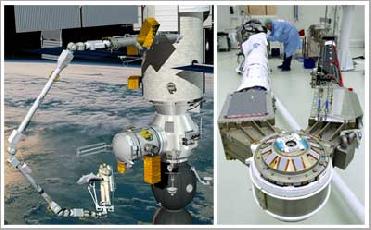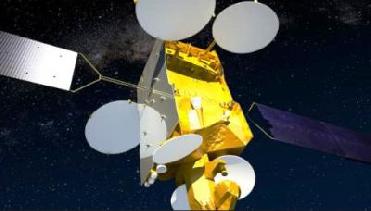
LEFT: Artist's impression of the European Robotic Arm on the ISS. Right: 'Elbow' of the ERA | An ESA photo(s)
Assembly and maintenance of the International Space Station (ISS) relies heavily on the use of extra-vehicular robotic systems.
Space robots can be sent into situations that are so risky that humans would not be allowed to go. They are important to our overall ability to operate in space because they can perform tasks less expensively or on an accelerated schedule, with less risk and occasionally with improved performance over humans doing the same tasks.
Space robots are generally designed to do multiple tasks - payload deployment, retrieval, or inspection; planetary exploration.
European Robotic Arm
European Robotic Arm (ERA) is a robotic servicing system, which will be used in the assembly and servicing of the Russian segment of the International Space Station.
On May 14, space shuttle Atlantis on its final mission to the space station had transported a spare elbow joint attached to the Russian Mini-Research Module 1 (MRM-1).
The International Space Station already features one robotic arm, the Canadarm2 but because of the different types of base points and payload mounting units that arm cannot be used on the Russian part of the ISS.
ERA also called the second 'intelligent' robot is smaller than Canadarm2. There is no "hand" or Special Purpose Dexterous Manipulator planned for it.
The robot arm has a total length of 11 metres and looks like a pair of compasses. It consists of two 'end-effectors' – dexterous hands, attaching the arm to the Station and routing power and command links – two wrists, two limbs and an elbow joint, together with electronics and cameras. Both ends can act as either a hand or the base.
Cosmonauts can control the robot from both inside as well as outside the space station. The intelligent space robot's most prominent feature is its ability to 'walk' around the exterior of the station under its own control.
Another important task for ERA will be to transport astronauts or cosmonauts like a cherry picker crane to the position where they are supposed to perform their work, or from one external location to another. ERA will use its infrared cameras for carrying out inspections of space station external surfaces.
ERA is developed by a European consortium led by Dutch Space, with subcontractors in eight countries. European Space Agency plans to launch the complete operational ERA in 2012 by a Proton rocket. Once ERA reaches ISS, the Russian Multipurpose Laboratory Module (MLM), on which it is installed during launch, will be the home base from which it operates.

• Installation and deployment of solar arrays
• Replacement of solar arrays
• Inspection of the station
• Handling of (external) payloads
• Support of astronauts during space walks
Canadarm-2
Mobile Servicing System (MSS), better known by its primary component Canadarm2 is the first ‘intelligent’ robot for the International Space Station.
Developed in Canada for the Canadian Space Agency, the robotic Canadarm2 was launched and added to the International Space Station (ISS) in 2001.
This robotic arm was used extensively for space station assembly for almost 10 years -- moving equipment and supplies around the space station, supporting astronauts working in space, and servicing instruments and other payloads attached to ISS.
The MSS is composed of the actual arm called Space Station Remote Manipulator (SSRMS), the Mobile Remote Servicer Base System (MBS) and the Special Purpose Dexterous Manipulator (SPDM also known as Dextre or Canada hand).

• Aiding in assembly of space station modules
• Helping during the docking process
• Moving equipment and supplies across or around the space station
• Performing necessary maintenance to ISS
• Working with large payloads
| Specifications | |
| ERA | CANADARM-2 |
| Total length: 11300 mm Reach: 9700 mm Tip position accuracy: 5 mm Maximum tip speed: 100 mm/s Launch mass:630 kg Mission handling capability: 8000 kg Main construction materials Limb: Carbon fibre tube and aluminum interfaces Wrist, Elbow and End Effector: Composed of many different materials Thermal Protection: Beta Cloth Blankets | Length: 17 metres Weight :1,641 kg Diameter : 35 cm (Ext. Diameter of Composite Boom) Speed of Operations: Unloaded: 37 cm/sec Loaded: Station assembly 2 cm/sec.; EVA support:15 cm/sec.; Orbiter: 1.2 cm/sec Composition: 19 plies of high strength carbon fibre– thermoplastic Repairs: Designed to be repaired in space with ORUs (Orbital Replacement Units). Built-in redundancy. |
Courtesy: ESA/ Canadian Space Agency/ NASA
 Previous Article
Previous Article Next Article
Next Article













The Indian Air Force, in its flight trials evaluation report submitted before the Defence Ministry l..
view articleAn insight into the Medium Multi-Role Combat Aircraft competition...
view articleSky enthusiasts can now spot the International Space Station (ISS) commanded by Indian-American astr..
view article